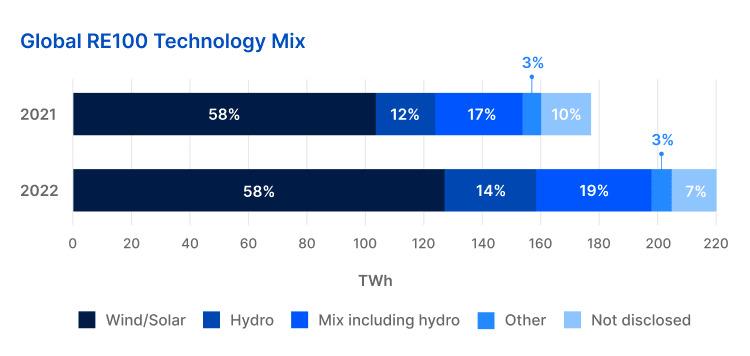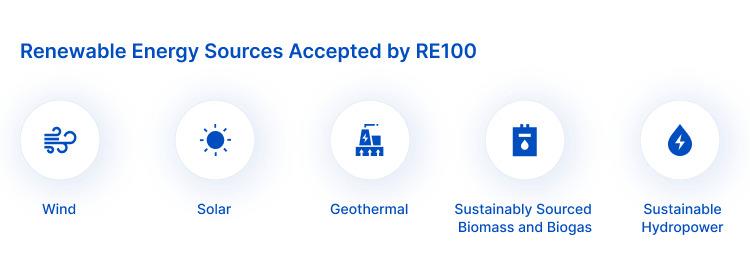RE100 Explained: Committing to 100% Renewable Energy

As the urgency to decarbonize intensifies, companies around the world are setting bold climate goals. And one of the clearest signals of ambition is joining RE100. This global initiative brings together businesses committed to sourcing 100% of their electricity from renewable energy. But what does it actually mean to be part of RE100? From eligibility requirements to how progress is tracked, this guide breaks down how RE100 works and what it takes to be a member.
What Is RE100
RE100 is a global corporate initiative that brings together major companies committed to sourcing 100% of their electricity from renewable energy. Launched in 2014 by Climate Group in partnership with CDP, the initiative aims to accelerate the shift to zero-carbon power systems. RE100 members play a key role in driving market demand for clean electricity and climate action. By setting a clear target and working toward it, these companies reduce their own emissions and also signal to suppliers, utilities, and policymakers that renewable energy is a business priority.
RE100 at a Glance
Launched: 2014
Members: 450+ companies
Markets Covered: 175+ countries
Electricity Consumption: 500+ TWh/year
% of Global Electricity: Over 1.5%
Membership Target: 100% renewable electricity by 2050 or earlier
Renewable Electricity Criteria
RE100 is focused specifically on renewable electricity, not other forms of energy like fuels or heat. RE100 defines renewable electricity as power sourced from technologies like solar, wind, sustainable hydropower, geothermal, and sustainably managed biomass. Nuclear energy doesn’t count under RE100’s definition. Even though it’s low-carbon, it’s not considered renewable in this context. Starting in 2025, only electricity from renewable facilities built within the last 15 years will fully count toward a company’s RE100 progress. Older sources can still be used, but only 15% of the electricity from those sites will be credited. This shift is meant to push companies toward newer projects and increase demand for additional renewable capacity. RE100 also requires geographic relevance when sourcing renewables. In most cases, renewable electricity must be sourced from the same market where it’s being consumed. This helps maintain the integrity of claims and encourages more local or regionally aligned procurement.


RE100’s Mission
RE100’s mission is to accelerate the global shift to 100% renewable electricity. Led by Climate Group, the initiative supports companies in meeting their renewable electricity targets through methods like green electricity purchases, power purchase agreements (PPAs), and on-site generation. But the impact doesn’t stop there. RE100 also mobilizes its members to advocate for energy policy changes. These include pushing for better grid access, stronger renewable energy markets, and supportive frameworks such as renewable energy certificate (REC) systems. This combined approach—business action plus policy influence—is central to RE100’s strategy for driving systems-level change.
How RE100 Works
The initiative is led by Climate Group in partnership with CDP. CDP (formerly the Carbon Disclosure Project) is a global nonprofit that runs a widely used environmental disclosure platform, helping companies measure and report their climate impacts. In RE100, Climate Group coordinates the campaign and drives global engagement. CDP provides technical expertise and manages the reporting framework. Members disclose their electricity use and renewable sourcing data through CDP’s platform. RE100 is also backed by philanthropic organizations and works with regional partners to grow participation worldwide. Since its launch at Climate Week NYC in 2014, RE100 has expanded rapidly. As of early 2025 counts over 450 member companies operating in 175 markets. Collectively, these businesses account for more than 500 terawatt-hours (TWh) of electricity demand per year. This is more than the annual consumption of countries like South Korea or France. By aggregating this demand, RE100 members are sending strong signals to energy markets and encouraging new renewable projects to come online.
Membership Scope
While there’s no strict size requirement, RE100 generally focuses on companies with significant electricity use—typically around 100 GWh annually—or strong market influence. Smaller companies can still become members if they play a strategic role in key sectors or regions. Originally, RE100 membership was limited to non-utility companies, but a few energy providers have since joined, committing to power their own operations with renewables.These members do not need to include customer supply in their commitment, as long as their own electricity use aligns with RE100’s renewable electricity criteria.
Regional RE100 Membership Growth
| 2016 | 2017 | 2018 | 2019 | 2020 | 2021 | 2022 | ||
|---|---|---|---|---|---|---|---|---|
| Europe | 65 | 77 | 95 | 111 | 124 | 127 | 128 | |
| Asis | 9 | 26 | 54 | 68 | 102 | 130 | 172 | |
| US | 42 | 53 | 71 | 82 | 89 | 98 | 103 |
Source: RE100 Annual Disclosure Reports 2022, 2023
Membership Criteria
RE100 has a defined set of criteria that companies must meet in order to join and maintain their membership. These requirements ensure that each member is genuinely committed to transitioning to 100% renewable electricity and contributing to broader market impact.
1. A Public Commitment to 100% Renewable Electricity
To join RE100, a company must commit to sourcing 100% of its electricity from renewable sources by a target date no later than 2050. This commitment must apply to all global operations—including all sites, countries, and any subsidiaries under operational control. RE100 requires the pledge to be made at the group level.
2. Interim Targets to Drive Progress
RE100 encourages companies to set interim goals to maintain momentum. While not initially mandatory, RE100 now expects members to aim for at least 60% renewable electricity by 2030 and 90% by 2040. These milestones help prevent delayed action and create accountability over time.
3. Annual Disclosure and Transparency
Transparency is central to RE100. Members must report annually on their electricity use and renewable share, either through the RE100 reporting template or CDP’s questionnaire. These reports detail not only how much renewable electricity is being used, but also how it’s being sourced—through power purchase agreements, on-site installations, or the purchase of renewable energy certificates. RE100 uses this data to publish aggregated progress reports across the membership.
4. Quality Standards for Renewable Sourcing
RE100 sets technical requirements for what counts as credible renewable electricity. All procurement must be unique, traceable, and additional—meaning it must be backed by recognized energy attribute certificates like RECs from North America, GOs from Europe, or global I-RECs. Double-counting is prohibited.
5. Third-Party Verification of Claims
Members are encouraged to verify their renewable energy use through independent third-party sources. This may include redemption certificates, audit documentation, or use certified green electricity products such as Green-e in the US.
6. Alignment with RE100’s Mission
RE100 requires members to support the initiative’s goals through action and advocacy. This means avoiding activities that undermine renewable energy adoption, such as lobbying against clean energy policies or expanding fossil fuel infrastructure.
Conclusion
RE100 has become a powerful platform for accelerating clean electricity adoption at scale. With over 450 companies already signed on, the initiative is helping reshape global energy markets. For companies ready to take a leadership role in the energy transition, RE100 offers a clear pathway and a structure for driving real progress.
Take Control of Your Emissions
and Sustainability Strategy Today!
Request DemoSummary
Introduction
What Is RE100
Renewable Electricity Criteria
RE100’s Mission
How RE100 Works
Membership Scope
Regional RE100 Membership Growth
Membership Criteria
Conclusion


